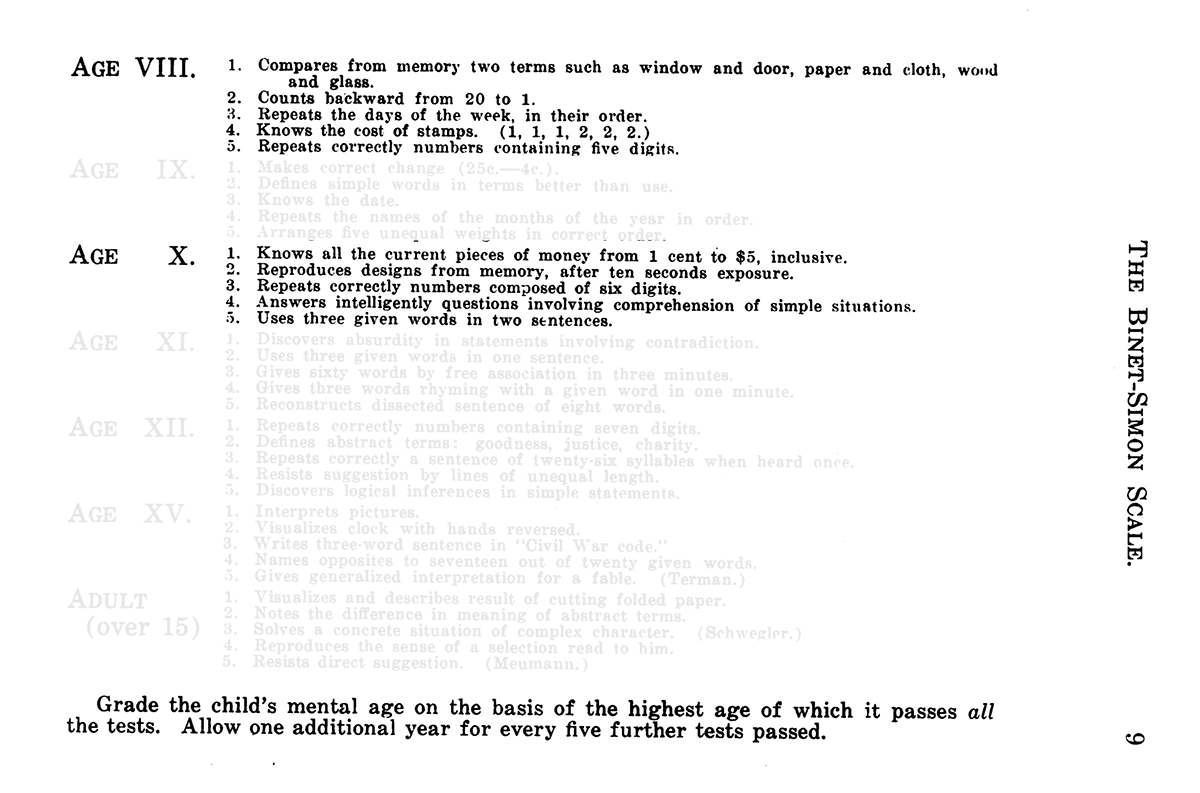You are here:
The Binet-Simon Scale, excerpt

Date: 1914
Caption: Psychologists developed intelligence tests or measures of “intelligence quotient” or “IQ.” They suggested that a “normal” child would be able to accomplish these tasks by the stated age.

In 1905, French psychologist and educator Albert Binet created a tool that he hoped would help to identify and understand children who were struggling in school. Binet’s scale identified particular tasks that a “normal” child was supposed to be able to complete by a given age. This came to be called the person’s “mental age,” meaning that an 18 year old who could complete the tasks listed for a 12 year old but not those of older children would be said to have a “mental age” of 12. Binet did not think that the scale measured student’s natural intelligence, and he thought that intelligence could change over time.1
American psychologists who learned of Binet’s work had different ideas. They thought of Binet’s test - which they built on and modified - as a way to measure students’ natural intelligence, and to predict what that intelligence would be over the course of the person’s life.2 Henry H. Goddard, working in New Jersey, and Lewis Terman, working at Stanford University in California, were two of the leading advocates for intelligence testing in US education.
Both made bold - and often racist - claims about intelligence in the US. Goddard claimed that at least two percent of the population was “feeble minded,” meaning they had some form of intellectual disability, even if they did not otherwise appear disabled. For this reason Goddard thought it was important to test widely to locate (and, he also argued, segregate) people labeled as “feeble minded.”3 Terman reported that Black students and Mexican students scored very low on his tests - which he took as evidence of their intellectual disability rather than a problem with the test.4
-
“Intelligence and Race, 1900-1930,” accessed July 22, 2023, https://understandingrace.org/history/science/race-and-intelligence-1900-1930/, and Steven Jay Gould, The Mismeasure of Man (New York: Norton, 1981). ↩︎
-
“Intelligence and Race, 1900-1930.” ↩︎
-
Henry H. Goddard, “The Menace of the Feeble Minded,” Pediatrics 23 (June 1911), https://babel.hathitrust.org/cgi/pt?id=chi.73416085&view=1up&seq=53, and James Trent, Inventing the Feeble Mind: A History of Mental Retardation in the United States (Berkeley: University of California Press, 1994). ↩︎
-
Gould, The Mismeasure of Man. ↩︎
Categories: K-12 organizing
Tags: disability labels, intellectual disabilities, racist segregation
This item is part of "Tests, Labels, and Segregation in New York City" in "Seeking Equity for Disabled Students"
Item Details
Date: 1914
Creator: Raymond A. Schwegler
Copyright: Public domain
How to cite: “The Binet-Simon Scale, excerpt,” Raymond A. Schwegler, in New York City Civil Rights History Project, Accessed: [Month Day, Year], https://nyccivilrightshistory.org/gallery/binet-simon.
Questions to Consider
- What factors in a child’s life could affect their ability to complete these tasks by age 8 or 10?
- Psychologist Henry H. Goddard said that a child’s experience in school had no affect on their mental age - it was all innate ability. Do you agree?
- How do you think that testing on this scale could be helpful? How could it be harmful?
- What experience have you had with intelligence testing? What experience have you had with other kinds of standardized testing?
References
How to Print this Page
- Press Ctrl + P or Cmd + P to open the print dialogue window.
- Under settings, choose "display headers and footers" if you want to print page numbers and the web address.
- Embedded PDF files will not print as part of the page. For best printing results, download the PDF and print from Adobe Reader or Preview.
